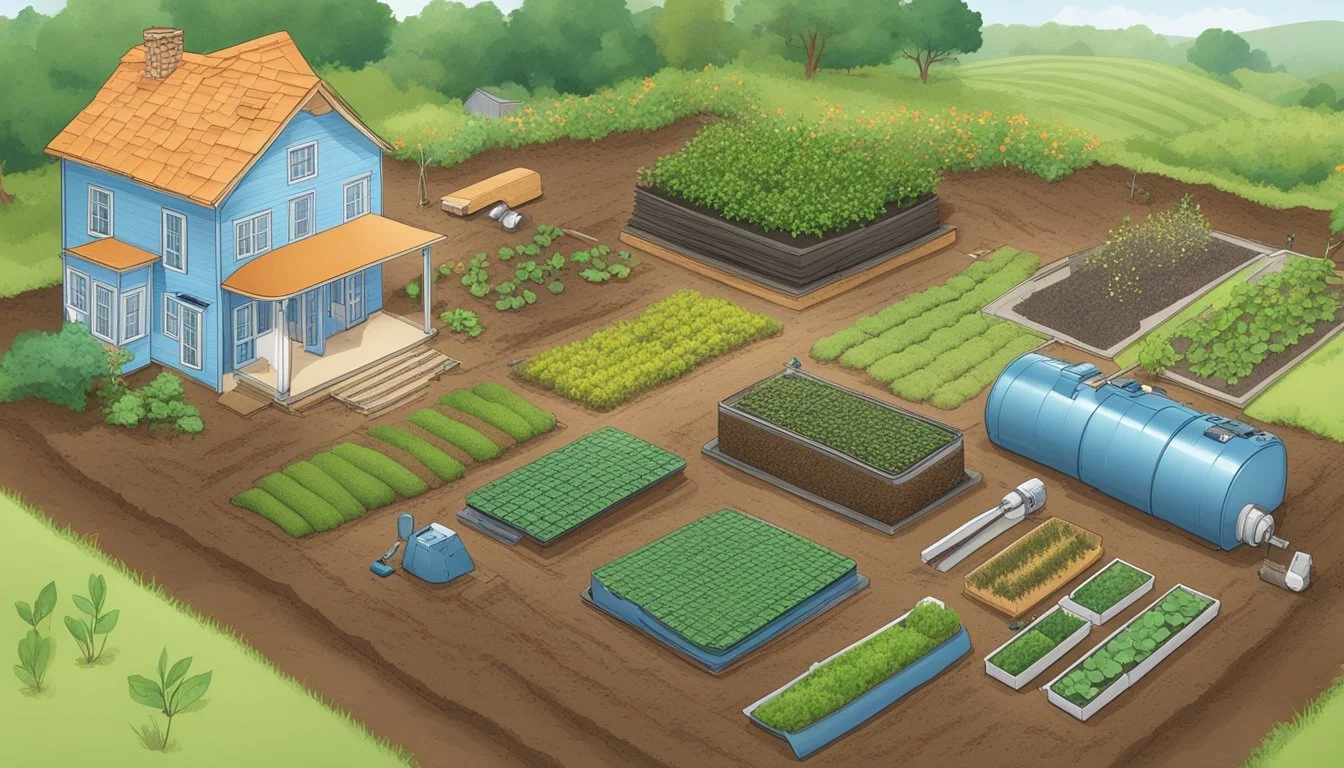Maximize Your Homestead's Soil Health
Uncover Nutrient Levels with Broad-Spectrum Testing
Maximizing soil health is crucial for homesteaders aiming to improve crop yield and maintain ecological balance. A broad-spectrum soil test kit is an essential tool for this task. It provides comprehensive information about the soil's current condition by measuring various parameters, such as pH, nutrient levels, and organic matter content. Understanding these factors is the first step towards making informed decisions about soil management and fertility enhancements. Assessing soil health with precision allows homesteaders to apply the correct amendments and embrace practices that foster robust soil ecosystems, thus ensuring long-term productivity and sustainability.
Using a broad-spectrum soil test kit empowers homesteaders to uncover subtle nuances in their soil's composition and health that might otherwise go unnoticed. Identifying soil deficiencies or excesses can guide the homesteader in choosing the right fertilizers and soil amendments. It also helps in determining the optimal timing for their application, mitigating the risk of over-fertilization, which can be as detrimental as neglect. By regularly monitoring soil health with a test kit, homesteaders can respond dynamically to the changing needs of their soil, promoting robust plant growth and resilience against pests and diseases.
The insights gained from these soil tests form the basis of a targeted management strategy, tailored to the unique needs of each homestead's soil. In turn, this strategy bolsters soil vitality and structure, allowing for a thriving ecosystem below the ground that supports the homestead's overall productivity. It's not only plants that benefit from healthy soil – a vibrant soil food web is critical for supporting a diverse range of life, from beneficial insects to microorganisms, that plays a role in the broader health of the homestead.
Understanding Soil Health
Soil health is fundamental for a productive homestead, directly impacting crop vitality and yield. It is gauged by various indicators, including those that affect the successful growth of common crops such as wheat, corn, and grass.
The Role of Soil in Agriculture
Soil acts as the reservoir for the essential nutrients and water that crops require. For wheat and corn to thrive, they rely on soil with adequate fertility and structure. During planting, seeds depend on the soil's condition to provide a suitable environment for germination and root development. Additionally, grass, a common cover crop, can contribute to the soil's health by protecting against erosion and helping maintain soil moisture.
Indicators of Soil Health
Soil health can be assessed through several key indicators:
Soil Texture and Structure: Impacts root growth and influences water retention and drainage.
pH Levels: A pH range of 6-7 is generally ideal for most crops, ensuring nutrient availability.
Nutrient Content: Essential nutrients include nitrogen, phosphorus, and potassium.
Organic Matter: Serves as a source of nutrients and promotes beneficial soil biology.
Soil Life: Healthy soil has active microorganisms that aid in breaking down organic matter and nutrient cycling.
Farmers and gardeners must regularly monitor these indicators to maintain soil health, ensuring the growth and sustainability of their crops.
Benefits of Broad-Spectrum Soil Testing
Broad-spectrum soil testing provides critical insights into soil composition, necessary for optimizing the growth of crops like wheat and corn. It helps homesteaders make informed decisions about soil amendment and fertility management.
Identifying Nutrient Deficiencies
A comprehensive soil test kit can detect levels of essential nutrients, including nitrogen (N), phosphorus (P), and potassium (K). These nutrients are vital for the robust growth of wheat and corn. Deficiencies can lead to poor crop yields and suboptimal plant health. For example, nitrogen is crucial for leaf development in wheat, while phosphorus promotes strong root growth in corn.
Wheat typically requires soil rich in nitrogen for stalk and leaf development.
Corn benefits from balanced phosphorus to ensure proper root development and potassium for overall growth and drought resistance.
Detecting Contaminants
Contaminants such as heavy metals and residual pesticides can compromise soil health and plant safety. Broad-spectrum testing can reveal the presence of these harmful substances, allowing for measures to mitigate their effects.
Contaminants like lead or arsenic can be particularly harmful if present in soil used to grow food crops.
Persistent pesticide residues can affect both wheat and corn by disrupting soil microorganisms that support plant nutrition.
By addressing nutrient deficiencies and contaminants, homesteaders can maintain soil health, leading to more bountiful harvests of wheat, corn, and other crops.
Selecting the Right Soil Test Kit
When optimizing soil health for seeding, planting, and harvesting on one's homestead, the choice of a soil test kit is crucial. These kits provide detailed insights into nutrient levels and pH balance, guiding amendments and fertilization choices.
Components of a Soil Test Kit
A comprehensive soil test kit typically includes tools to measure pH, as well as essential nutrients like nitrogen (N), phosphorous (P), and potassium (K), often referred to as N-P-K values. Higher-end kits may offer more elaborate testing options for micronutrients and environmental toxins.
pH Measurement: A vital aspect that affects nutrient availability to plants.
Nutrient Levels: Identifies the concentrations of N, P, K, which influence growth, root development, and fruiting.
How to Choose a Test Kit
To choose an appropriate soil test kit, one must consider the type of crops being cultivated and the specific soil management goals. Test kits range from basic analog options to sophisticated digital devices.
User-friendliness: Look for simple instructions and clear, easy-to-read results.
Accuracy: Digital kits or those with lab validation often deliver precise readings.
Depth of Analysis: Comprehensive kits that measure a broad spectrum of elements will provide a more complete assessment of soil health, aiding in better decision-making for planting and harvesting schedules.
It is suggested to select a kit that balances ease of use with the depth of insight needed for the intended agricultural practices.
Conducting the Soil Test
A thorough soil test is crucial to determine soil health and fertility. These tests provide essential information needed to tailor soil amendments and ensure optimal plant growth.
Step-by-Step Guide
To conduct a soil test using a broad-spectrum soil test kit, one follows a systematic process:
Sampling: Utilize a clean trowel to dig soil samples from the homestead. Target a depth of 6-10 inches to gather a representative profile of the soil.
Harvesting Samples: Zigzag across the garden to collect random samples, aiming for 10-15 different points to avoid skewed results.
Storing Samples: Combine these samples in a clean bucket. Mix thoroughly to homogenize, removing debris like stones and roots.
Testing: From the mixed soil, take a 2-cup portion for the test. Follow the kit's specific instructions to perform the analysis, which usually involves adding soil to chemical reagents and comparing color changes to a chart provided.
Interpreting Test Results
After completing the test:
pH Levels: Check if the soil is too acidic or alkaline. Adjustments may be made by adding lime or sulfur accordingly.
Nutrient Content: Identify levels of key nutrients, typically nitrogen (N), phosphorus (P), and potassium (K). An imbalance can indicate which fertilizers are needed.
Soil Life: An assessment of microorganisms can reveal soil biological activity, a sign of soil health.
Texture and Structure: Soil test results can also infer the soil's physical properties, contributing to water retention and root development.
Improving Soil Health
To maximize a homestead's output, soil health must be top priority. Soil testing kits are crucial in identifying deficiencies and guiding targeted improvements.
Organic Matter and Composting
Incorporating organic matter into the soil is essential for nutrient supply and structure. One can achieve this through composting, which involves the breakdown of organic wastes such as leaves, kitchen scraps, and manure. These materials decompose and contribute to the soil's fertility, aiding in planting and harvesting cycles. An optimal compost mix should maintain a carbon to nitrogen ratio between 25:1 and 30:1 for effective decomposition.
Here is a simple guideline for composting:
Greens (e.g., vegetable scraps, coffee grounds): Provide nitrogen
Browns (e.g., dry leaves, branches): Supply carbon
Water: Keep the compost pile moist
Air: Regularly turn the pile to introduce oxygen, which supports aerobic decomposition
Crop Rotation and Diversity
Crop rotation involves changing the types of crops grown in an area across a sequence of seasons. This practice reduces the pressure of pests and diseases, and it helps balance the nutrients in the soil. Diverse planting, including a mix of crop species, supports a wide range of soil microbes and enhances soil structure and function.
A strategic crop rotation might follow this pattern:
Legumes (nitrogen-fixing)
Leafy greens (nitrogen consumers)
Root vegetables (phosphorus consumers)
Cereals/grasses (potassium consumers)
Each group brings different benefits and demands on the soil, creating a balanced system that can result in healthier crops and soil. Storing seeds from diverse plants additionally ensures that a variety of species can be introduced in subsequent planting seasons.
Global Perspectives on Soil Management
Soil management practices vary significantly around the world, reflecting the unique challenges and opportunities presented by diverse climates, landscapes, and cultural traditions. From Europe's advanced techniques to Asia's innovative methods, each region has developed distinct approaches to enhance soil health.
European Techniques
In Europe, efforts to promote sustainable soil management are often supported by policy frameworks and advanced science. Techniques such as crop rotation and controlled traffic farming minimize soil compaction and erosion, preserving soil structure and fertility.
Asian Innovations
Asian countries have pioneered soil health strategies tailored to their varied terrains and climates. In particular, the use of rice paddies in water management exemplifies how traditional practices can be both sustainable and productive.
African Practices
Africa's soil management strategies are deeply rooted in traditional knowledge, often involving crop diversity and intercropping to maintain soil health. However, faced with challenges such as desertification, African farmers also incorporate modern techniques like conservation agriculture to improve resilience.
Indian Agricultural Methods
India employs a mix of traditional and contemporary practices to manage its soils. Vermicomposting and no-till farming are gaining popularity for their role in maintaining soil structure and enhancing microbial activity, which is vital to soil health.
Andean Strategies
The Andes region is known for its unique terraced farming, which helps prevent soil erosion on steep slopes. Andean farmers also practice polyculture and use organic matter as fertilizer to enhance soil fertility and protect against the harsh mountainous environment.
From Test Results to Action
A broad-spectrum soil test kit provides an extensive look into soil health, arming homesteaders with crucial data to make informed decisions. Translating test results into tangible practices is key for optimizing soil conditions specifically for wheat and corn cultivation.
Developing a Soil Health Plan
Upon receiving soil test results, a homesteader should first assess pH levels and nutrient balances, which are fundamental to plant health. For instance, ideal pH levels for wheat typically range from 6.0 to 7.5, with similar preferences for corn. Soil amendments may be necessary if pH levels fall outside this range. Based on the findings, a homesteader's soil health plan should prioritize:
Soil pH adjustment: Applying lime to raise pH or sulfur to lower it, as needed.
Fertility enhancement: Focusing on the three primary nutrients:
Nitrogen (N): Critical for leaf growth, with corn requiring more nitrogen than wheat.
Phosphorus (P): Essential for root development and reproductive growth.
Potassium (K): Important for overall plant health and disease resistance.
Homesteaders should adjust the quantity and timing of amendments according to the crop needs. For example, wheat requires a balanced input of these nutrients at specific growth stages, while corn is more demanding in nitrogen during its vegetative growth phases. Ensuring adequate organic matter content is also vital for soil structure and fertility.
Implementing Best Practices
With the plan in place, implementation should be timed and precise. Best practices include:
Site-Specific Management: Applying nutrients and pH adjustments only where needed, which prevents over-application and supports environmental stewardship.
Cross-Checking Results: Before full-scale application, apply the plan on a smaller plot to validate results and make necessary adjustments to avoid large-scale errors.
Effective soil health management strategies could include:
Crop Rotation: Alternating wheat and corn with legumes can enhance nitrogen levels naturally.
Cover Crops: Utilizing cover crops during off-season to prevent erosion and maintain nutrient levels.
Conservation Tillage: Reducing tillage to maintain soil structure and organic matter content.
These actions should be taken in moderation and with continual monitoring to maintain a neutral approach that fosters both soil health and sustainable crop yields for wheat and corn.
Case Studies
The case studies presented below are drawn from real-world examples where soil health practices played a significant role either in the success of agricultural endeavors or provided learning experiences from less than successful attempts. They exemplify the implications and outcomes tied to soil health management.
Success Stories in Soil Health Improvement
Minnesota Farm: A farmer in Minnesota achieved substantial economic gains by introducing diverse crops into his operations, reducing reliance on herbicides, and creating diversified revenue streams through direct-market beef and pioneering crops like Kernza®. The investment in soil health led to reduced input costs and enhanced farm sustainability.
Increased Farm Productivity: Row crop farmers and almond growers reported increased yields attributed to improved soil health. The reported increase ranged between $14 to $151 per acre for row crops and $46 to $968 per acre for almonds. These figures reflect the tangible financial benefits of adopting soil health practices.
Lessons Learned from Failed Attempts
Challenges in Transition: Some farmers experience decreased yields initially when transitioning to soil health-oriented practices due to a gap in experience or resources. It's crucial to note the importance of a well-planned transition and the need for technical support during this phase to mitigate risks.
Economic Pressures: At times, short-term economic pressures have led to decisions that compromise soil health, demonstrating that long-term planning is essential for sustained soil health benefits. These cases serve as a reminder of the financial considerations that must be juggled alongside ecological concerns.
Future of Soil Health Technologies
Exploring the future of soil health technologies reveals a promising landscape for both soil testing and farming practices. These advancements aim to sustainably manage soil health for improved agricultural productivity.
Advancements in Soil Testing
The trajectory for soil testing technology is steering towards more sophisticated, rapid, and comprehensive methods. New broad-spectrum soil test kits are being developed to provide a deeper understanding of soil composition, incorporating mechanisms to detect a wide variety of nutrients and soil health indicators. Innovations include:
Portable Spectrometers: These devices use reflectance spectroscopy to analyze soil samples on-site, giving immediate insights into soil nutrition and contaminants.
DNA-based Soil Analysis: Progressive techniques involve analyzing the DNA of soil microorganisms to assess the biodiversity, which is crucial for soil health maintenance.
Innovative Farming Techniques
In correlation with advanced testing methods, innovative farming techniques are focusing on improving soil vitality through technology. They incorporate:
Precision Agriculture: Utilizes data from advanced soil tests to apply precise amounts of water, fertilizer, and pesticides, which helps in reducing waste and improving yield.
Cover Cropping and Crop Rotation: Supported by soil health data, farmers can optimize these practices to enhance soil structure and biodiversity, leading to a more resilient ecosystem.
By harnessing these technological advances, the future of soil health looks to be on a path that not only elevates agricultural efficiency but also promotes environmental sustainability.





